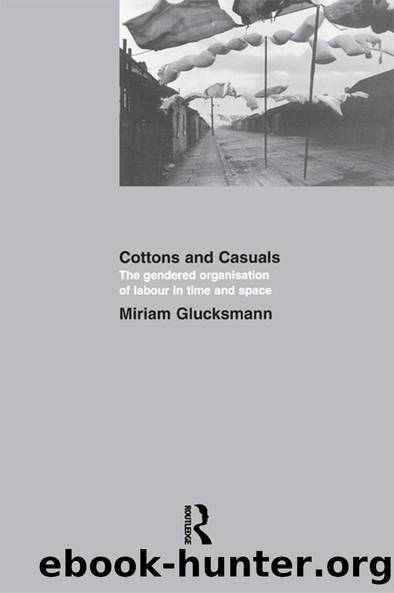Cottons and Casuals: The Gendered Organisation of Labour in Time and Space by Miriam Glucksmann

Author:Miriam Glucksmann [Glucksmann, Miriam]
Language: eng
Format: epub
Tags: Social Science, Sociology, General
ISBN: 9781134280933
Google: wQveAAAAQBAJ
Publisher: Routledge
Published: 2013-09-13T04:50:08+00:00
... and youth out of work
Appreciation of the spatial variations in employment and unemployment helps throw light on the second, and ostensibly quite opposite, area of concern, namely the consumption patterns and leisure activities of young people. This issue too aroused vigorous debate both at the time and more recently. When did teenagers and teenage culture make their first appearance? Was it after the Second World War in the relatively more affluent 1950s, as popular wisdom suggests, following Abrams (1961)? Or do recent social and oral historians have a point in dating the the emergence of âpostwarâ adolescent culture in the 1930s?
While some researchers (e.g. Roberts, 1984: 42â3, 1995a: 45â6; to some extent also Davies, 1992a: 83) emphasise the continuing childlike dependence and submission of young workers within the family, others (e.g. Fowler, 1988: 206â16,1992; echoing Harley, 1937; James and Moore, 1940; Jephcott, 1942) emphasise their relative affluence and autonomy, and argue that leisure activities and spending patterns evident in the 1930s were precursors of the 1950s.
Young Mancunians certainly enjoyed high rates of economic activity and correspondingly high levels of disposable income.9 Their leisure pursuits were the object of considerable scrutiny at the time and appear to have been a popular topic for MA studentsâ dissertations at Manchester University (Fielder, 1932; Middleton, 1931; Harley, 1937; Thompson, 1937). Their comments frequently assume the âdo-goodingâ tone common to contemporary social surveys (noted in Chapter 2), implying that young people's time and money could be better spent on more edifying activity. Harley was particularly critical of the cinema, having discovered that 90 per cent of her sample of girl workers attended at least once a week and that some went as many as six times, and this was in addition to dance halls. Her criticism extended further, to the girlsâ supposedly undiscriminating consumption of magazines and the âglorification of materialismâ to which they exposed themselves.
Jephcott was less censorious, her criticisms reserved for cinema and film. Nevertheless, she was equally concerned with how to improve girls and their lot.
Veronica Lake and Lana Turner do more for the girl of fourteen than merely set her hairstyle... young people... are forming their tastes... and basing their conception both of worthwhile entertainment and of a life that is worth living on the standards set by the film corporations. On the whole these are standards which exhalt violence, vulgarity, sentimentality and false psychology.â (Jephcott, 1942: 119)10
The passion for dancing came in for less condemnation because Jephcott judged its socially and physically active character to be beneficial to young women:
Dancing provides one solution to this urgent need for movement and it is a solution that requires much less mental alertness than, for example, a keep-fit class ... psychologists tell us that rhythmical movement is a recognized means by which relief is afforded to anxiety. (Jephcott, 1942: 122)
Moreover:
Girls also appreciate the sociability of a dance hall and the company of their contemporaries ... she can wear a smart frock and good stockings and try to look really glamorous before her equals.
Download
This site does not store any files on its server. We only index and link to content provided by other sites. Please contact the content providers to delete copyright contents if any and email us, we'll remove relevant links or contents immediately.
| Africa | Americas |
| Arctic & Antarctica | Asia |
| Australia & Oceania | Europe |
| Middle East | Russia |
| United States | World |
| Ancient Civilizations | Military |
| Historical Study & Educational Resources |
Cecilia; Or, Memoirs of an Heiress — Volume 1 by Fanny Burney(32064)
Cecilia; Or, Memoirs of an Heiress — Volume 3 by Fanny Burney(31459)
Cecilia; Or, Memoirs of an Heiress — Volume 2 by Fanny Burney(31409)
The Secret History by Donna Tartt(18168)
Sapiens: A Brief History of Humankind by Yuval Noah Harari(13993)
Leonardo da Vinci by Walter Isaacson(12807)
The Radium Girls by Kate Moore(11624)
Sapiens by Yuval Noah Harari(5125)
How Democracies Die by Steven Levitsky & Daniel Ziblatt(4965)
The Wind in My Hair by Masih Alinejad(4847)
Homo Deus: A Brief History of Tomorrow by Yuval Noah Harari(4691)
Endurance: Shackleton's Incredible Voyage by Alfred Lansing(4508)
Man's Search for Meaning by Viktor Frankl(4292)
The Silk Roads by Peter Frankopan(4275)
Millionaire: The Philanderer, Gambler, and Duelist Who Invented Modern Finance by Janet Gleeson(4105)
The Rape of Nanking by Iris Chang(4024)
Hitler in Los Angeles by Steven J. Ross(3801)
The Motorcycle Diaries by Ernesto Che Guevara(3788)
Joan of Arc by Mary Gordon(3786)
